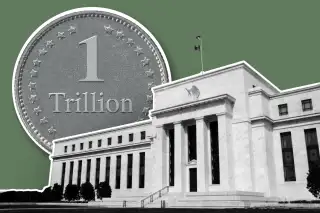The U.S. Government Could Run out of Money in October. Is Minting a $1 Trillion Coin the Solution?

The fight on Capitol Hill over the debt ceiling continues as the country heads for a potential government shutdown. Some say the solution is a $1 trillion coin.
On Tuesday, U.S. Treasury Secretary Janet Yellen said the U.S. government could run out of cash by Oct. 18 if Congress doesn't raise or suspend the debt limit.
"At that point, we expect Treasury would be left with very limited resources that would be depleted quickly," Yellen wrote in a letter to House Speaker Nancy Pelosi.
As lawmakers clamor to avoid what could be an economic crisis, they've raised the coin idea, which seems to pop up whenever a debt-ceiling debate comes along. But what is happening with the debt ceiling, and is the seemingly absurd concept of a $1 trillion platinum coin actually a viable solution?
The debt ceiling
The federal government has a fixed limit on the amount of money the Treasury Department can borrow — currently $28.4 trillion. The debt limit, which was suspended for two years, came back into effect in August. As the debt grows larger, suspending or raising that limit is up to Congress.
President Joe Biden and the Democrats want to raise this debt ceiling, but Republicans have blocked a bill that would increase that limit. It's certainly not the first time lawmakers have faced this issue. Fights over the debt ceiling came about in 2011 and 2013 as well.
The outcome of not raising the debt limit could be an "economic catastrophe," according to Yellen. We're talking about a possible recession, including tons of job losses, as the U.S. is just recovering from economic pain left in the wake of the COVID-19 pandemic. It's hard to say exactly what the damage would look like, but back in 2017 Standard and Poor’s chief U.S. economist said that failure to raise the debt ceiling would probably be "more catastrophic to the economy than the 2008 failure of Lehman Brothers."
Even waiting just a bit longer could do damage.
"An extended impasse is likely to cause significant damage to the U.S. economy," experts at the Brookings Institute, a think tank in Washington D.C., wrote. "Even in a best-case scenario where the impasse is short lived, the economy is likely to suffer sustained — and completely avoidable — damage, particularly given the challenges that COVID-19 poses to the health of the economy."
Yellen is urging Congress to act fast.
"We know from previous debt limit impasses that waiting until the last minute can cause serious harm to business and consumer confidence, raise borrowing costs for taxpayers, and negatively impact the credit rating of the United States for years to come," Yellen wrote in the letter to Pelosi on Tuesday. "Failure to act promptly could also result in substantial disruptions to financial markets, as heightened uncertainty can exacerbate volatility and erode investor confidence."
As Senate Minority Leader Mitch McConnell has pointed out, the Democrats have the ability to raise the debt ceiling on their own via the budget reconciliation process, which would only require them to reach a majority threshold instead of get 60 votes. But some Democrats are rejecting this tactic, including Senate Majority Leader Chuck Schumer, saying that it is complicated and could take weeks.
The trillion dollar coin
There is another potential solution to this problem: the Treasury could mint a "commemorative" one trillion dollar coin. The coin could then be deposited to the Federal Reserve, and the government could continue paying its bills.
Advocates for minting the coin point out that there is no cap on the value of commemorative coins — and so a value of $1 trillion is, technically, possible.
On Tuesday, Pelosi told reporters that Rep. Jerry Nadler D-N.Y. raised the idea of the $1 trillion coin. Rep. Rashida Tlaib D-MI tweeted #MintTheCoin.
The White House rejected the idea earlier this month, however.
“There is only one viable option to deal with the debt limit: Congress needs to increase or suspend it, as it has done approximately 80 times, including three times during the last Administration,” White House spokesperson Mike Gwin told Politico.
The coin solution was also floated back in 2013, and former President Barack Obama later admitted that he had considered it. In 2017 on the "Pod Save America" podcast, Obama said that when former House Speaker John Boehner didn't get enough votes to make sure the government didn't default on its debt — which the former president called the scariest moment of his presidency — the administration considered several options, including having the U.S. Treasury mint the $1 trillion coin.
But most economic experts don't seem to be on board with the coin solution. The arguments include that it would shake global investors' confidence, and perhaps set a bad precedent by giving Congress a way to avoid doing its job.
"The trillion dollar coin is a badly flawed effort to workaround the debt limit that will make a bad situation even worse," said Mark Zandi, chief economist for Moody's Analytics, according to CNN.
More from Money:
When to Expect the Next Stock Market Correction, According to Investment Pros
What if Federal Student Loan Interest Rates Just Stayed at 0% Forever?
What's the Best Country for Retirement? The U.S. Isn't Even in the Top 10